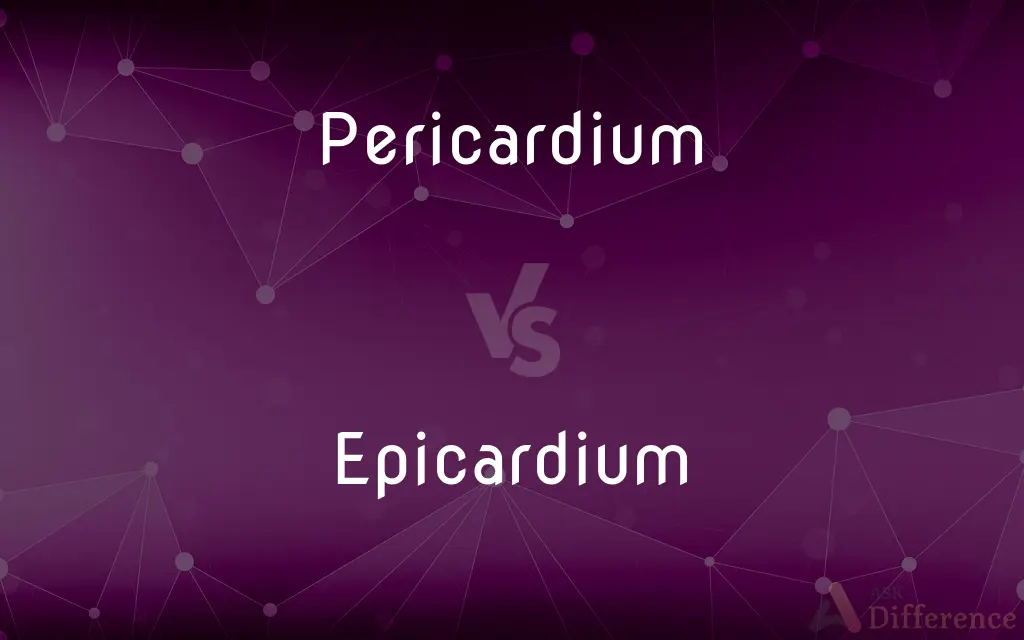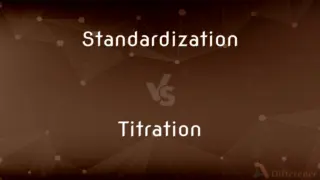Pericardium vs. Epicardium — What's the Difference?
By Urooj Arif & Fiza Rafique — Updated on March 11, 2024
The pericardium is the protective sac surrounding the heart, while the epicardium is the outermost layer of the heart wall, lying directly on the heart.

Difference Between Pericardium and Epicardium
Table of Contents
ADVERTISEMENT
Key Differences
The pericardium is a fibrous sac encompassing the heart and the roots of the major vessels, providing protection and anchorage, minimizing over-expansion. The epicardium, on the other hand, serves as the heart's outer layer, being one of the three layers of the heart wall and directly in contact with the pericardial fluid.
While the pericardium consists of two main layers: the fibrous pericardium and the serous pericardium (which further divides into the parietal and visceral layers, the latter also known as the epicardium), the epicardium itself is a thin layer of tissue that lies just beneath the visceral layer of the serous pericardium and is in direct contact with the heart muscle.
The function of the pericardium extends to limiting the heart's motion within the chest, providing a barrier against infections, and contributing to the lubrication of the heart's movement through the pericardial fluid. In contrast, the epicardium plays a role in protecting the heart muscle and contains the coronary blood vessels that supply the heart.
Diseases affecting these structures can manifest differently: pericarditis involves inflammation of the pericardium, which can lead to sharp chest pain and other symptoms, whereas conditions affecting the epicardium, such as epicardial fat buildup, can influence heart function and overall cardiovascular health.
The pericardium's structure allows it to withstand various physiological and pathological conditions, maintaining the heart's position in the thorax. The epicardium, however, contributes significantly to the metabolic needs of the heart by providing a protective layer that contains essential blood vessels and nerves.
ADVERTISEMENT
Comparison Chart
Definition
Protective sac surrounding the heart
Outermost layer of the heart wall
Layers
Fibrous pericardium and serous pericardium
Single thin layer, part of the serous pericardium
Function
Protects and anchors the heart, minimizes over-expansion, lubricates movement
Protects heart muscle, contains coronary vessels
Diseases
Pericarditis, pericardial effusion
Epicardial fat buildup, coronary artery disease
Role in Heart Health
Limits heart's motion, barrier against infections
Supplies heart with blood, influences metabolic needs
Compare with Definitions
Pericardium
Protective sac around the heart.
The pericardium secures the heart within the chest.
Epicardium
Outermost heart wall layer.
The epicardium directly covers the heart muscle.
Pericardium
Limits heart's excessive motion.
The pericardium ensures the heart maintains its position during vigorous activities.
Epicardium
Contains coronary blood vessels.
The epicardium's vascular network supplies the heart with oxygen.
Pericardium
Shields heart from infections.
The pericardium acts as a barrier against pathogens.
Epicardium
Thin layer of tissue.
The epicardium is delicate and closely adheres to the heart muscle.
Pericardium
Comprises fibrous and serous layers.
The serous layer of the pericardium provides lubrication.
Epicardium
Involved in metabolic functions.
The epicardium plays a role in the heart's metabolic needs.
Pericardium
Associated with pericarditis.
Inflammation of the pericardium can lead to sharp chest pains.
Epicardium
Can accumulate fat.
Excessive fat in the epicardium can impact heart health.
Pericardium
The pericardium, also called pericardial sac, is a double-walled sac containing the heart and the roots of the great vessels. It has two layers, an outer layer made of strong connective tissue (fibrous pericardium), and an inner layer made of serous membrane (serous pericardium).
Epicardium
That part of the pericardium which forms the outer surface of the heart; the cardiac pericardium.
Pericardium
A serous membrane that surrounds the heart allowing it to contract.
Epicardium
The inner layer of the pericardium that is in actual contact with the surface of the heart.
Pericardium
The double baglike fold of serous membrane which incloses the heart.
Epicardium
(anatomy) The layer of tissue between the pericardium and the heart.
Pericardium
A double-layered serous membrane that surrounds the heart
Epicardium
The innermost of the two layers of the pericardium
Common Curiosities
How does the pericardium protect the heart?
It limits excessive motion, serves as a barrier against infections, and provides lubrication for heart movements.
Can the epicardium accumulate fat?
Yes, excessive epicardial fat can build up and potentially affect heart function.
What is pericarditis?
Pericarditis is the inflammation of the pericardium, often causing chest pain and other symptoms.
What is the function of the epicardium?
The epicardium serves as the outermost layer of the heart wall, containing coronary vessels and supporting metabolic functions.
What diseases affect the pericardium?
Conditions like pericarditis and pericardial effusion can affect the pericardium.
How can epicardial fat impact cardiovascular health?
Excessive epicardial fat can lead to inflammation and potentially increase the risk of coronary artery disease.
What are the layers of the pericardium?
The pericardium consists of the fibrous pericardium and the serous pericardium, which includes the parietal and visceral layers (epicardium).
What is the pericardium?
The pericardium is the fibrous sac that encloses the heart, providing protection and stability.
Is the epicardium the same as the pericardium?
No, the epicardium is part of the heart wall, while the pericardium is the protective sac that surrounds the heart.
Can the pericardium affect heart function?
Yes, disorders of the pericardium can impact heart function by restricting its movement or causing fluid accumulation.
What happens during pericardial effusion?
In pericardial effusion, excess fluid accumulates between the pericardium and the heart, potentially impairing cardiac function.
What role does the pericardial fluid play?
It lubricates the heart's movement, reducing friction between the heart and the pericardium.
What measures can protect the pericardium and epicardium?
Maintaining cardiovascular health through a balanced diet, regular exercise, and monitoring of risk factors can help protect these heart structures.
Share Your Discovery

Previous Comparison
Standardization vs. Titration
Next Comparison
Hemiacetal vs. HemiketalAuthor Spotlight
Written by
Urooj ArifUrooj is a skilled content writer at Ask Difference, known for her exceptional ability to simplify complex topics into engaging and informative content. With a passion for research and a flair for clear, concise writing, she consistently delivers articles that resonate with our diverse audience.
Co-written by
Fiza RafiqueFiza Rafique is a skilled content writer at AskDifference.com, where she meticulously refines and enhances written pieces. Drawing from her vast editorial expertise, Fiza ensures clarity, accuracy, and precision in every article. Passionate about language, she continually seeks to elevate the quality of content for readers worldwide.
















































